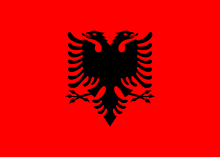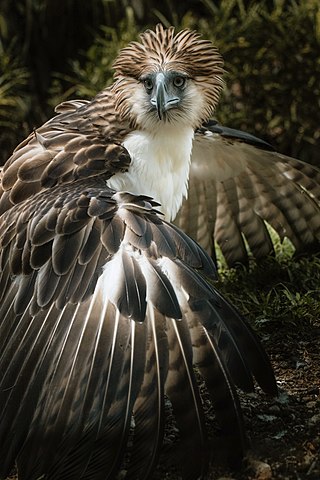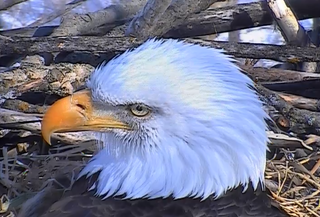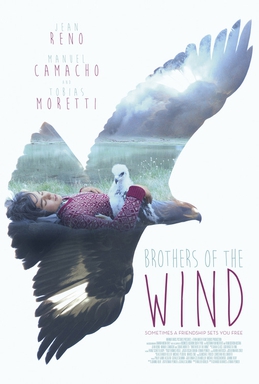This article needs additional citations for verification .(May 2024) |

The Tale of the Eagle is an Albanian folk tale that explains how Albania and Albanians received their indigenous name. [1]
This article needs additional citations for verification .(May 2024) |

The Tale of the Eagle is an Albanian folk tale that explains how Albania and Albanians received their indigenous name. [1]
A youth was hunting in the mountains. An eagle flying above him alighted on top of a crag. The eagle was especially large and had a snake in its beak. After a while, the eagle flew away from the crag where it had its nest. The youth then climbed to the top of the crag where he saw, in the nest, an eaglet playing with the dead snake. However, the snake was not dead. Suddenly it stirred, revealed its fangs and was ready to pierce the eaglet with its deadly venom. The youth quickly took out his bow and arrow and killed the snake. Then he took the eaglet and started for his home. Suddenly the youth heard above him the loud whir of the great eagle's wings.
"Why do you kidnap my child?" cried the eagle.
"The child is mine because I saved it from the snake which you didn't kill," answered the youth.
"Give me back my child, and I will give you as a reward the sharpness of my eyes and the powerful strength of my wings. You will become invincible, and you will be called by my name!"
Thus the youth handed over the eaglet. After the eaglet grew, it would always fly above the head of the youth, now a grown man, who with his bow and arrows killed many wild beasts of the forest, and with his sword slew many enemies of the land. During all of these feats, the eagle faithfully watched over and guided him.
Amazed by the valiant hunter's deeds, the people of the land elected him king and called him Shqipëtar , which is to say Son of the Eagle (shqipe or shqiponjë is Albanian for eagle) and his kingdom became known as "Shqipëria" or Land of the Eagles.The two heads on the eagle represent the north and the south.

The Philippine eagle, also known as the monkey-eating eagle or great Philippine eagle, is a critically endangered species of eagle of the family Accipitridae which is endemic to forests in the Philippines. It has brown and white-colored plumage, a shaggy crest, and generally measures 86 to 102 cm in length and weighs 4.04 to 8.0 kg.

The simurgh is a benevolent bird in Persian mythology and literature. It bears some similarities with mythological birds from different origins, such as the phoenix and the humā. The figure can be found in all periods of Iranian art and literature and is also evident in the iconography of Georgia, medieval Armenia, the Eastern Roman Empire, and other regions that were within the realm of Persian cultural influence.

The Labours of Hercules or Labours of Heracles are a series of tasks carried out by Heracles, the greatest of the Greek heroes, whose name was later romanised as Hercules. They were accomplished in the service of King Eurystheus. The episodes were later connected by a continuous narrative.

The bateleur is a medium-sized eagle in the family Accipitridae. It is often considered a relative of the snake eagles and, like them, it is classified within the subfamily Circaetinae. It is the only member of the genus Terathopius and may be the origin of the "Zimbabwe Bird", the national emblem of Zimbabwe. Adult bateleurs are generally black in colour with a chestnut colour on the mantle as well as also on the rump and tail. Adults also have gray patches about the leading edges of the wings with bright red on their cere and their feet. Adults also show white greater coverts, contrasting with black remiges in males, gray patches on the underwing primaries and black wingtips. The juvenile bateleur is quite different, being largely drab brown with a bit of paler feather scaling. All bateleurs have extremely large heads for their size, rather small bills, large feet, relatively short legs, long, bow-like wings and uniquely short tails, which are much smaller still on adults compared to juvenile birds.

Alerion is a term for a heraldic bird. Historically, it referred to the regular heraldic eagle. Later, heralds used the term alerion to refer to "baby eagles" or "eaglets". To differentiate them from mature eagles, alerions were shown as an eagle displayed inverted without a beak or claws (disarmed). To differentiate it from a decapitate (headless) eagle, the alerion has a bulb-shaped head with an eye staring towards the dexter of the field. This was later simplified in modern heraldry as an abstract winged oval.
Prâslea the Brave and the Golden Apples is a Romanian fairy tale collected by Petre Ispirescu in Legende sau basmele românilor.

Little Wildrose is a Romanian fairy tale. Andrew Lang included it in The Crimson Fairy Book.

An ala or hala is a female mythological creature recorded in the folklore of Bulgarians, Macedonians, and Serbs. Ale are considered demons of bad weather whose main purpose is to lead hail-producing thunderclouds in the direction of fields, vineyards, or orchards to destroy the crops, or loot and take them away. Extremely voracious, ale particularly like to eat children, though their gluttony is not limited to Earth. It is believed they sometimes try devouring the Sun or the Moon, causing eclipses, and that it would mean the end of the world should they succeed. When people encounter an ala, their mental or physical health, or even life, are in peril; however, her favor can be gained by approaching her with respect and trust. Being in a good relationship with an ala is very beneficial, because she makes her favorites rich and saves their lives in times of trouble.

The brown snake eagle is a fairly large species of bird of prey in the family Accipitridae. It is found in West, East and southern Africa. This species is an almost obligate predator of a variety of snakes. A very solitary bird, the brown snake eagle has a prolonged breeding cycle and raises a single eaglet. Although probably naturally scarce, it is classified as a least concern species as it continues to occur over a very broad range.

Conquest is a 1983 dark fantasy film directed by Lucio Fulci. The film plot involves Ilias a young man who battles monsters and mutants on his journey to manhood. Conquest was reviewed by both AllMovie and The Monthly Film Bulletin, who noted the films low budget and derivative nature, while finding the film to be surprisingly entertaining despite its negative aspects.

Shooting an apple off one's child's head, also known as apple-shot is a feat of marksmanship with a bow that occurs as a motif in a number of legends in Germanic folklore. In the Stith Thompson Motif Index it is F661.3, described as "Skillful marksman shoots apple from man's head" or "apple shot from man's head", though it always occurs in the form of the marksman being ordered to shoot an apple off his own son's head. It is best known as William Tell's feat.

Sir Eglamour of Artois is a Middle English verse romance that was written sometime around 1350. It is a narrative poem of about 1300 lines, a tail-rhyme romance that was quite popular in its day, judging from the number of copies that have survived – four manuscripts from the 15th century or earlier and a manuscript and five printed editions from the 16th century. The poem tells a story that is constructed from a large number of elements found in other medieval romances. Modern scholarly opinion has been critical of it because of this, describing it as unimaginative and of poor quality. Medieval romance as a genre, however, concerns the reworking of "the archetypal images of romance" and if this poem is viewed from a 15th-century perspective as well as from a modern standpoint – and it was obviously once very popular, even being adapted into a play in 1444 – one might find a "romance [that] is carefully structured, the action highly unified, the narration lively."

The Decorah Bald Eagles is a website featuring a live-streaming webcam trained on a bald eagle nest and family in Decorah, Iowa. The Raptor Resource Project installed and runs the live stream for research purposes. It is one of more than a dozen eagle webcams across the United States.

Vasilisa the Beautiful is a 1940 Soviet children's fantasy film produced by Soyuzdetfilm and directed by Alexander Rou. It was based on a traditional Russian fairy tale The Frog Tsarevna , rather than the fairy tale of the same name. It was the first large-budget feature in the Soviet Union to use fantasy elements, as opposed to the realistic style long favored politically.

Brothers of the Wind is a 2016 Austrian coming of age-drama film directed by Gerardo Olivares and Otmar Penker and starring Jean Reno, Manuel Camacho and Tobias Moretti.

King Lindworm or Prince Lindworm is a Danish fairy tale published in the 19th century by Danish folklorist Svend Grundtvig. The tale is part of the more general cycle of the Animal as Bridegroom, and is classified in the Aarne–Thompson–Uther Index as tale type ATU 433B, a type that deals with maidens disenchanting serpentine husbands.

The Sea Tsar and Vasilisa the Wise is a Russian fairy tale published by author Alexander Afanasyev in his collection of Russian Fairy Tales, numbered 219. The tale features legendary characters Sea Tsar and Vasilisa the Wise.
The Beautiful Palace East of the Sun and North of the Earth is a Swedish folktale collected from Smaland by Swedish folktale collectors George Stephens and Gunnar Olof Hyltén-Cavallius. It features versions of the swan maiden, a mythic female character that alternates between human and animal shapes.
The Son of the Horse is a folktale from the Salar people, an ethnic minority in China. It concerns a hero of animal parentage and his adventures with two companions. Similar stories are located in China, among its ethnic minorities.